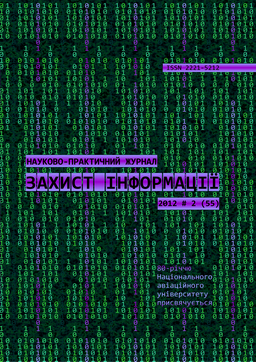ЗАСТОСУВАННЯ МЕТОДІВ ШТУЧНОГО ІНТЕЛЕКТУ В СИСТЕМАХ АНТИВІРУСНОГО ЗАХИСТУ
DOI:
https://doi.org/10.18372/2410-7840.14.2181Ключові слова:
антивірус, комп’ютерний вірус, штучний інтелект, теорема Баєса, штучні нейронні мережі, метод опорних векторівАнотація
В статті розглянуті основні методи штучного інтелекту в контексті застосування системами антивірусного захисту. Наведена оцінка їх ефективності та перспективи застосування. Розглянуто можливості створення “розумних” систем антивірусного захисту на основі штучного інтелекту.Посилання
Люгер Д. Ф. Искусственный интеллект, стратегии и методы решения сложных проблем – Вильямс, 2003. – 864 с.
Рассел С., Норвиг П. Искусственный интеллект: современный подход. М.: Вильямс, 2007. – 1408 с.
Friedman N., Geiger D., Goldszmidt M., Bayesian Network Classifiers // Machine Learning. 1997. 29. P. 131– 165.
Хайкин С. Нейронные сети: полный курс. 2-е изд. М.: Издательский дом Вильямс, 2006. – 1104 с.
Зайцев О. Нейросети в системах безопасности [Текст] // IT-Спец. – 2007. – № 6. – С. 54–59.
Vapnik V. Statistical learning theory. Wiley, New York, 1998.
Vapnik V. N. The Nature of Statistical Learning Theory. Springer-Verlag, 1995. Lashkov P., Schäfer C., Kotenko I. Intrusion Detection in Unlabeled Data with Quarter-Sphere Support Vector Machine
##submission.downloads##
Номер
Розділ
Ліцензія
Автори, які публікуються у цьому журналі, погоджуються з наступними умовами:- Автори залишають за собою право на авторство своєї роботи та передають журналу право першої публікації цієї роботи на умовах ліцензії Creative Commons Attribution License, котра дозволяє іншим особам вільно розповсюджувати опубліковану роботу з обов'язковим посиланням на авторів оригінальної роботи та першу публікацію роботи у цьому журналі.
- Автори мають право укладати самостійні додаткові угоди щодо неексклюзивного розповсюдження роботи у тому вигляді, в якому вона була опублікована цим журналом (наприклад, розміщувати роботу в електронному сховищі установи або публікувати у складі монографії), за умови збереження посилання на першу публікацію роботи у цьому журналі.
- Політика журналу дозволяє і заохочує розміщення авторами в мережі Інтернет (наприклад, у сховищах установ або на особистих веб-сайтах) рукопису роботи, як до подання цього рукопису до редакції, так і під час його редакційного опрацювання, оскільки це сприяє виникненню продуктивної наукової дискусії та позитивно позначається на оперативності та динаміці цитування опублікованої роботи (див. The Effect of Open Access).

